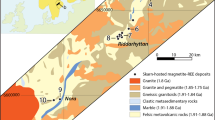Abstract
Very large iron ore deposits have formed in many parts of the world, evidently by the supergene alteration of Precambrian banded-iron formation (BIF). Some of these deposits extend to great depths, ranging to 2,400 m at Krivoyrog1, beyond the likely reach of oxygenated water. We propose here, on the basis of studies in the Hamersley Ranges, Western Australia, a mechanism for deep-seated ore formation in which electronic conduction through the magnetite layers in BIF connects a cathodic region near the surface, where oxygen is reduced, to an anode at depth, where iron (II) from magnetite, carbonates and silicates is oxidized and precipitated as iron (III) hydroxyoxides. The electrical circuit is completed by ionic conduction through groundwaters. The model is based broadly on a mechanism suggested by Sato and Mooney2 to explain self-potentials associted with sulphide ore bodies. It is based more specifically on a model demonstrated by Thornber3 for the weathering of massive nickel–iron sulphide deposits at Kambalda, Western Australia, but with substantial differecnes in the physical situation and the reactions at depth.
This is a preview of subscription content, access via your institution
Access options
Subscribe to this journal
Receive 51 print issues and online access
$199.00 per year
only $3.90 per issue
Buy this article
- Purchase on Springer Link
- Instant access to full article PDF
Prices may be subject to local taxes which are calculated during checkout
Similar content being viewed by others
References
Belevtsev, Y. N. in Proc. Kiev. Symp. Genesis of Precambrian Iron and Manganese Deposits, 167–180 (Unesco, Paris, 1973).
Sato, M. & Mooney, H. M. Geophysics 25, 226–249 (1960).
Thornber, M. R. Chem. Geol. 15, 1–14 (1975).
Trendall, A. F. & Blockley, J. G. Bull. 119. Geol. Sun. West. Australia (1970).
Morris, R. C. Econ. Geol. 75, 184–209 (1980).
Dorr, J. van N. II Econ. Geol. 59, 1203–1240 (1964).
Bourn, R. & Jackson, D. G. Proc. West Australia Conf. 1979, 187–201 (Australasian Institute of Mining and Metallurgy, 1979).
Gilhome, W. R. Economic Geology of Australia and Papua New Guinea, 892–898 (Australasian Institute of Mining and Metallurgy, 1975).
Kneeshaw, M. Economic Geology of Australia and Papua New Guinea, 910–916. (Australasian Institute of Mining and Metallurgy, 1975).
Berge, J. W., Johansson, K. & Jack, J. Econ. Geol. 72, 582–607 (1977).
Jones, D. A. Ind. Engng Chem. Prod. Res. Devel. 11, 12–23 (1972).
James, H. L., Dutton, C. E., Pettijohn, F. J. & Wier, K. L. U.S. Geol. Survey. Prof. Pap. 570 (1968).
Berge, J. W. Econ. Geol. 66, 947–960 (1971).
Author information
Authors and Affiliations
Rights and permissions
About this article
Cite this article
Morris, R., Thornber, M. & Ewers, W. Deep-seated iron ores from banded-iron formation. Nature 288, 250–252 (1980). https://doi.org/10.1038/288250a0
Received:
Accepted:
Issue Date:
DOI: https://doi.org/10.1038/288250a0
This article is cited by
-
Increased solubility of quartz following ferrous–ferric iron reactions
Nature (1987)
-
Electrochemistry and the geochemist
Nature (1980)
Comments
By submitting a comment you agree to abide by our Terms and Community Guidelines. If you find something abusive or that does not comply with our terms or guidelines please flag it as inappropriate.



